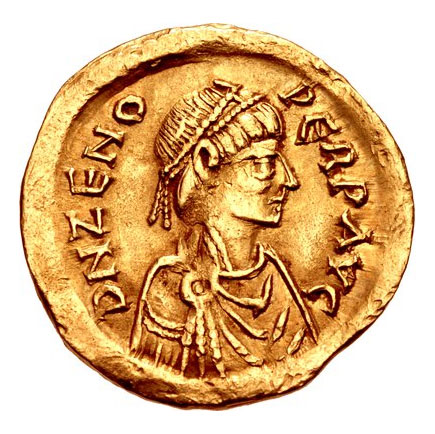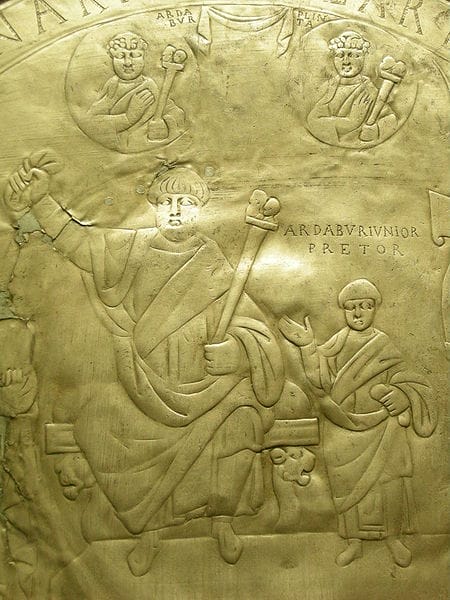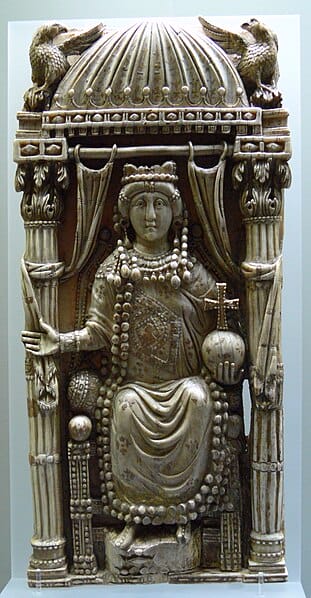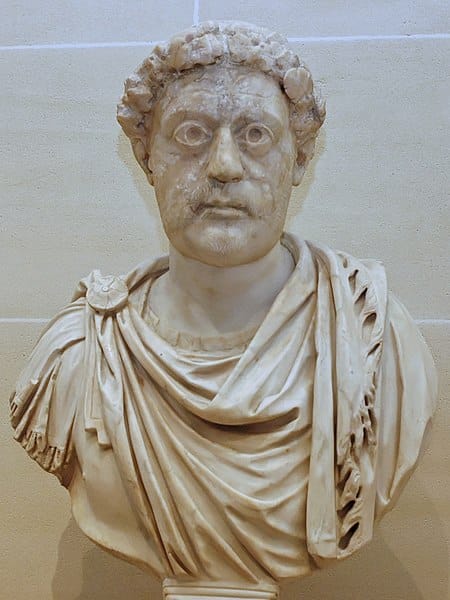Life: AD ? – 491

- Name: Tarasikodissa
- Born in Rosoumblada in Isauria (Asia Minor).
- Consul AD 469.
- Became emperor 9 February AD 474.
- Wife: (1) Arcadia, (2) Aelia Ariadne.
- Died AD 491.
Early Life
Zeno was from Rosoumblada in the province in south-eastern Asia Minor known as Isauria. The emperor Leo called him to Constantinople as the leader of a force of Isaurians in order to counter the ever-growing German influence over the empire. Also, a special imperial guard was set up, made up entirely of Isaurians, and Zeno was granted command of this highly important force.
It was only at that stage that he assumed the name Zeno. Apparently, it was the name of a dignitary of high standing back in Isauria, and Zeno thought it more suitable for his new high office to have a name less common than Tarasicodissa. To further increase the bond with his new Isaurian guardsmen, Leo married his elder daughter Aelia Ariadne to Zeno.
Becoming Master of Soldiers
In AD 467-8, he was given the powerful position of ‘Master of Soldiers’ in Thrace to repel an assault by the Huns under the son of Attila, Denzig (Densegich).
Though Aspar, the powerful German ‘Master of Soldiers’ of the eastern empire, well understood Zeno as an ambitious new opponent and sought to see him out of the way. An assassination attempt was made by a group of soldiers at his behest, but he managed to escape to Serdica (Sofia) in advance.
In AD 469, he held the consulship. Afterward, she was granted the post of ‘Master of Soldiers’ of the eastern provinces. In this role, he set out to deal with brigands and banditry of the Isaurian warlord Indacus. But his ambition suffered a setback as Leo elevated Aspar’s son Patricius to the rank of Caesar and betrothed him to his daughter Leontia. Further, still Aspar, through his elder son Ardaburius, was trying to win the support of his power base, the Isaurian guard, in order to regain supremacy over his rival. Zeno moved back to Chalcedon, from where he could influence matters in Constantinople.

Aspar’s attempts to see his son made heir to the throne had outraged many in the capital, as his Arian beliefs were a heresy to the orthodox Christians of Constantinople. Among the mayhem and rioting that ensued, he arranged the assassination of Aspar and Ardaburius (AD 471). Next, in AD 473, he was made ‘Master of Soldiers’ of the eastern empire, taking Aspar’s place. In October AD 473, Leo elevated his five-year-old grandson, who was the son of Zeno and Aelia Ariadne, to be co-emperor Leo II.
Becoming co-Augustus
On 18 January AD 474, Leo died, and Leo II was the sole emperor, with Zeno as regent of the eastern empire. But already on 9 February, he was appointed co-Augustus by the senate. Before the year AD 474 was over, Leo II was dead. There were rumors that he had killed his own son to have the throne for himself. On his accession, he enjoyed a good relationship with the West. The current Western emperor, Julius Nepos, was related by marriage to Zeno’s wife.

Meanwhile, relations with the Vandals though suffered, as King Geiseric was still angry at the assassination of Aspar, a fellow German, and clearly had preferred his influence over the East to that of Zeno. With relations so soured, Geiseric invaded Epirus and captured the city of Nicopolis. However, after this initial hostility, a treaty was alas agreed and peace was restored.
But just as Geiseric had at first taken offense, so too did the Ostrogothic chief Theodoric Strabo seize the opportunity of Aspar’s death to renew hostilities with the eastern empire. After early successes, he eventually was brought to a halt by the Isaurian general Illus.
The Plan to Overthrow Zeno
Illus himself soon was the cause of trouble to Zeno, as he became involved in a conspiracy against the emperor at Constantinople. The conspiracy was a far-reaching one, involving even Zeno’s mother-in-law and widow of Leo, Aelia Verina. The plan was to overthrow Zeno and instead place Aelia Verina’s lover, Patricius, on the throne.
Further, Illus’ brother Trocundes and Aelia Verina’s brother Basiliscus were also involved in the conspiracy. Zeno, though, received a warning that his life was in danger and fled to his homeland of Isauria. The Senate, though, rejected Patricius as the new emperor and instead decided on Basiliscus (AD 475).
However, Basiliscus’ reign was not to last for long. So unpopular was his rule, that he soon lost much of the support which had carried him to power. One of the key moments in Basiliscus’ demise was when Illus, the very general who had plotted against him, decided that his rule was so bad that he would instead rejoin Zeno and help him back to power.

Zenos’ March on Constantinople
With Illus’ support, Zeno now marched out of Isauria towards Constantinople. So unpopular was Basiliscus by then that an army that was sent against them, under the command of Armatus, the empress’ lover, purposely avoided them to allow them an unopposed passage toward the capital.
There was simply no resistance when Zeno re-entered his capital in August AD 476. One of his first roles as re-instated emperor was to oversee the formal end of the Western Empire, traditionally referred to as ‘The fall of Rome.‘ Had his initial colleague Julius Nepos been driven out of Italy and replaced by Romulus Augustus, then the new emperor had also been forced to abdicate when Odoacer had led a rise of the German mercenary troops in Italy.
Odoacer now demanded recognition as ruler of Italy, though at least offered to do so in the name of the eastern empire. Was Odoacer’s submission to the eastern throne purely a theoretical one, with little practical meaning – it at least allowed for the hope in the east of one day recovering the Italian territories from the Germans. Zeno recognized Odoacer as a patrician (patricius) and ruler of Italy, though insisted on Julius Nepos continuing, though in exile, as emperor of the West.
People Also Ask:
What is emperor Zeno known for?
Zeno (born, Isauria, Diocese of the East—died April 9, 491) was the Eastern Roman emperor whose reign (474–91) was troubled by revolts and religious dissension. Until he married the Eastern emperor Leo I’s daughter Ariadne (in 466 or 467), Zeno had been known as Tarasicodissa.
What was the reign of Zeno?
Zeno (Greek: Ζήνων, c. 425 – 9 April 491) was an Eastern Roman emperor from 29 August 474 – 9 January 475 (First Reign) and August 476 – 9 April 491 (Second Reign). He had witnessed the fall of the Western Roman Empire along with the accession of Odoacer into Italy.
How long has Zeno ruled?
Zeno was a Byzantine emperor from 474 until 491 CE. An ethnic Isaurian, he was repeatedly criticized as an outsider during his reign, which was full of rebellions and attacks by the Ostrogoths.
What is higher than a emperor?
In eras where much of the world was ruled by an emperor (including the Medieval world), the only equivalent power to an emperor would be a religious figure — namely, a pope. But in the government and political world, the emperor is the highest you can get.
Who are the daughters of emperor Zeno?
Near Eastern and other Christian traditions maintain that Zeno had two daughters, Hilaria and Theopiste, who followed a religious life, but historical sources attest to the existence of only one son by Arcadia, called Zenon.

Historian Franco Cavazzi dedicated hundreds of hours of his life to creating this website, roman-empire.net as a trove of educational material on this fascinating period of history. His work has been cited in a number of textbooks on the Roman Empire and mentioned on numerous publications such as the New York Times, PBS, The Guardian, and many more.
